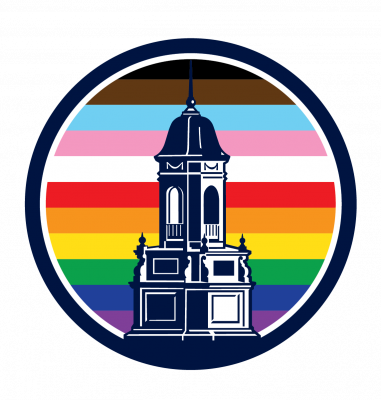Frederick Biggs Professor of English, Co-Director of Medieval Studies, received a CLAS book fund award.
"I have been involved for most of my career in a vast, collaborative project called SASLC, the Sources of Anglo-Saxon Literary Culture. As the name suggests, we have set out to survey all of the classical and medieval works that allowed creative minds in England before the Norman Conquest (1066) to compose works such as Beowulf that have endured through the centuries because they continue to teach us. But times do change, as the image opposite from a Bible produced in England under the direction of Bede (d. 735) may remind us: all knowledge no longer fits in a single bookcase. Jumping over that minor invention of 1451, printing, we are now in an age when books based on big data must be supported electronically,
and for the good of scholarship, in open-access form. One part is a wiki that we can run for free (https://saslc.wikispaces.com). But another is the construction of a database robust enough to handle many kinds of information, allowing all to be search in multiple ways. In collaboration with the University of Amsterdam Press and thanks to the support of the CLAS book fund, the volumes on Bede that George Hardin Brown and I have completed as part of the larger project will receive that support."
Bede. Part 1, Faxcles 1-4. George Hardin Brown and Frederick M. Biggs. Amsterdam: Amsterdam University Press, 2017.
Bede. Part 2, Faxcles 1-4. George Hardin Brown and Frederick M. Biggs. Forthcoming. Amsterdam: Amsterdam University Press, 2018.
http://press.uchicago.edu/ucp/books/book/distributed/B/bo20267432.html
From the Introduction:
In any account of the literary culture of Anglo-Saxon England, Bede must loom large. While only one of many distinctive voices for whom we have a written record, Bede stands out as the author who turned a lifetime of study into the widest-ranging corpus of writings, many of which continued to influence later generations. Theodore, archbishop of Canterbury, and Hadrian, abbot of St Peter’s Canterbury, may have been better educated and more able teachers. Aldhelm, the Beowulf-poet, and, to choose one more example from among many, Cynewulf may have written better verse. Boniface, archbishop and martyr, may have changed more lives through his mission. Alcuin, abbot of Tours, may have carried English scholarship more effectively to the Continent. Alfred the Great’s support of education may have occurred at a more crucial moment in English history. Dunstan, archbishop of Canterbury, Æthelwold, bishop of Winchester, and Oswald, bishop of Worcester and archbishop of York, may have instituted a more significant reform. Ælfric, abbot of Eynsham, and Wulfstan, archbishop of York, may have preached better sermons. Bede, however, left writings that demonstrate his skills and influence in all these areas, ones that those who followed him, as these entries and the ones that will complete this survey in the next volume of SASLC show, would almost certainly have known.
Evaluating Bede’s place in this literary culture is sometimes complicated because, as these works demonstrate, his own reading, which was both wide and deep, appears often in his writing. When in the well-known autobiographical passage at the end of the Historia ecclesiastica gentis Anglorum (V.xxiv) he spoke of having been sent at the age of seven by his kinsmen to enter the monastery of Monkwearmouth.





